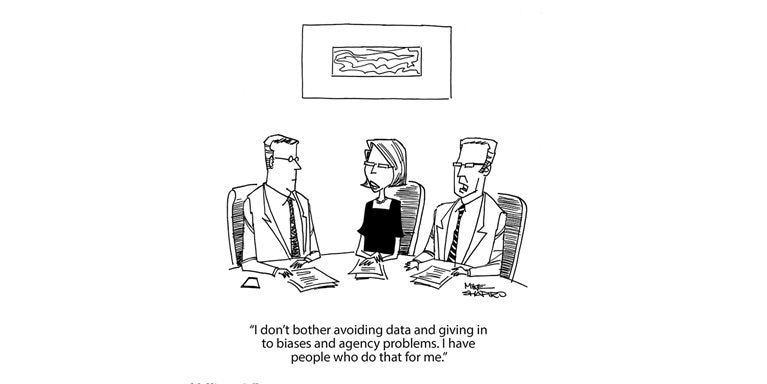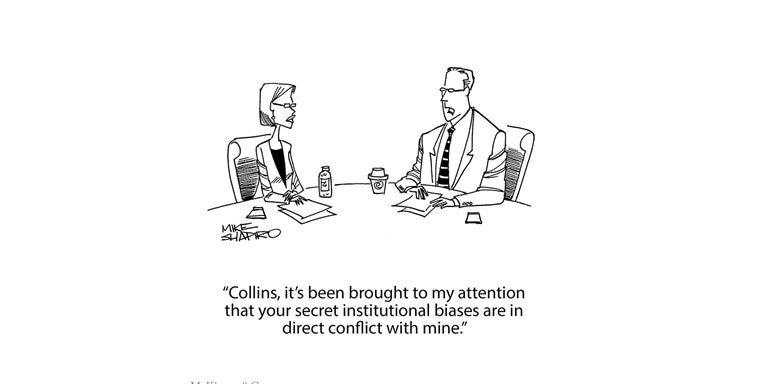The common method of developing a strategy starts bottom up: compile all the facts you can gather about your specific situation, then synthesize them into tailored recommendations. Sounds good, right? Problem is, it’s often wrong. That’s because this approach doesn’t account for the unknown unknowns: the surprises, shocks and strokes of luck that get in the way of plans. Moreover, as you gather more and more information, your confidence in your assumptions grows even faster. It’s like reading your own mail.
In his classic book Thinking, Fast and Slow, Daniel Kahneman recounts a first-hand experience of the perils of the inside view. Midway through an effort to design a new syllabus and textbooks for the Israel Ministry of Education, he polled members of his team about how long the project would take to complete. The answers, made by secret ballot, projected between 1.5 and 2.5 years. He then asked: What is the experience of teams like ours in developing a curriculum from scratch? The answer was sobering: 40% did not finish, and those that did took seven to 10 years.
Kahneman’s textbook was eventually finished—in eight years. The forecasts of seasoned academics were off by 300%. “The inside view is the one all of us spontaneously adopted to assess the future of our project,” Kahneman writes. “We focused on our specific circumstance and searched for evidence from our own experience…. At the time, there was no way for us to foresee the succession of events that would cause the project to drag on for so long: divorces, illnesses, crises of coordination with bureaucracies.”

In strategy, the importance of an outside view is even more vital. In our new book, Strategy Beyond the Hockey Stick, we talk a lot about the social side of strategy. As I explained in my last blog, this is the real drama in the strategy room, with egos, competing incentives, biases and politics playing the starring roles. The result is the perfect environment for the inside view to take hold and truly fester.
Think of how a selective use of the facts and the tendency toward storytelling can make the inside view highly malleable. Ever seen a market share summary that flattered one’s position by adopting a conveniently tight definition of the overall market? Similarly, when performance is good, we praise management victories, but when performance is bad, there’s a long list of external reasons on which we lay the blame (the competition was tough, the weather was bad).
Embracing the outside view can help get you over these hurdles. Rather than relying on your experience and selected facts, the outside view draws on broad characteristics from large data samples. It focuses on ranges and probabilities. Most people believe that more analysis yields better answers. So it’s quite surprising to them that an outside view of probabilities based on just a few characteristics proves much more accurate than the bottom-up plan.

My co-authors and I developed a model of corporate performance that has an 86% predictive accuracy based on just 10 numbers. The idea that 10 attributes can determine the odds of a strategy succeeding seems counterintuitive. Surely, we are asked, other variables such as talent, leadership, culture, and the deeper details of execution matter? There is powerful research to suggest that they do. Yet even without factoring them in, our outside perspective explains more than 80% of the probability of a company’s position and movement along the Power Curve of economic performance.
It’s actually pretty easy to use the outside view in practice. Here are three steps:
1. Determine the base rate. Ask how feasible a given goal is based on the broad corporate population. The CEO of a large company I know had a bold aspiration: to grow at double digits over the subsequent decade, even though his company had only grown at the rate of inflation during the prior period. The question he needed to pose was, “OK, how many companies, and how many large companies, actually manage double-digit growth?” There is a very specific answer to that: 20.6% of all companies, and 9.6% of large companies (according to the very useful Credit Suisse base rate book). When it comes to strategic success more broadly, our research shows that the average “base rate” is 8%. That’s the chance a company that starts in the middle of the Power Curve has of jumping to the top 20% over a 10-year period.
2. Revise the base rate up or down based on your differences from the typical sample member. This is exactly what we do in the book with our 10 variables. You can move your odds up if you have a better than average starting point (your endowment) and trends, and if you make certain moves. As an analogy, consider that 19,121 people have tried to scale Mt. Everest since Hillary did it in 1921. Only 32% of them have made it to the summit. But if I tell you that you will face much harsher weather, your guide is significantly less experienced, and you’ve done 50% less physical preparation than the average climber you would be wise to downgrade your own odds of a successful ascent.
Back to our magic 8% number: Once we measure the endowment, trends and moves of the companies in our sample, we can model their odds. Yes, there are a few high-odds companies that failed “despite the odds” and a few low-odds companies that succeeded “against all odds,” but these are exceptions that prove the rule.
3. Make your plans as big as your aspirations. It’s okay to aspire to become a 1-in-10 breakout success—provided you have a 1-in-10 strategy. Too often, business leaders use up all their boldness in setting the aspiration and have little left when it comes to making the committed strategic choices and moves needed to realize their goal (see my blog on “Hockey stick dreams hairy back reality”). Go back to the Everest climber: Train more, get a better guide, and wait for good weather. Then your aspiration will be backed by real substance.
Strategy rooms can get stuffy, full of recycled hot air, and this is where the social side of strategy tends to take over. A strategic approach that uses the outside view to calibrate aspirations will be like a breath of fresh air.
Go on, open the windows!
Chris Bradley is a partner in our Sydney office and co author of Strategy Beyond the Hockey Stick with Sven Smit and Martin Hirt.
Originally published on LinkedIn
